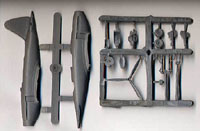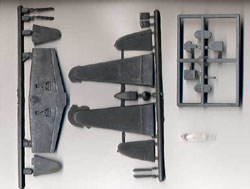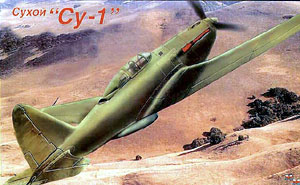MM (Siga) 1/72 Sukhoi Su-1 By Will Perry | | History As the thirties ended, even the conservative commissars in the Kremlin realized that Polikarpov I-16’s and anachronistic 153’s weren’t keeping pace with the rest of the aviation world. Russian aircraft designers were tasked with developing new generation of fighters that would bring Soviet designs up to par. Pavel Sukhoi's design used the compact Klimov M-105P engine with a pair of turbosuperchargers to provide high altitude performance. The prototype Su-1 (also known as the I-330) flew in August of 1940. Test pilots praised its handling and near 400-mph top speed. When things were working right, the plane's service ceiling was around 41,000 feet. Unreliable superchargers proved to be the plane's Achilles' heel- most test flights were flown without the units. In August of 1941, the Wehrmacht inspired the design bureau to head East. The Su-1 was damaged in the move and never repaired. A similar Su-3, with shorter wings, was built and flown, but also failed because of finicky superchargers.  The Kit The Kit
This boxing says "Manufactured by MM & Packed by Siga", though the same kit seems to be available from Interavia. This is a Ukrainian company, and the molding quality is reminiscent of the better-known Amodel. The sturdy box contains four small sprues and an injected canopy - 36 parts total. The good news - panel lines are engraved and straight, and most surfaces are relatively smooth. But there are gritty areas, indistinct panel lines and extraneous warts and lumps. The reviewed example had a couple of small short-shots and a big chunk of one fuselage half seems to have been broken off. The canopy was lumpy and not particularly clear. Details are lumpy and crude. The pilot's seat is acceptable, but, if you like nice cockpits, you'll be scratchbuilding or adapting a resin set (interior from the Encore MiG-3 might be an inexpensive option). The spares box would be your best bet for landing gear and a propeller.  References aren't exactly thick in the field, and there seem to be only two photos of the plane. Luckily, one photo is a good side-view. This photo, and the scale drawings from the 8-88 Model Konstructor were reduced to 1/72nd scale to do a direct comparison to the kit parts. The wing planform compares well with the drawings, though the kit sweeps the wing a few degrees more than the plans. The drawings indicate that the fuselage is about 3 mm short behind the cockpit. The 1/72 photo, however, indicates that about 4 mm should be added just ahead of the wing. Because of lens distortion, it's hard to be sure, but that photo sure shows a lot more engine out front. References aren't exactly thick in the field, and there seem to be only two photos of the plane. Luckily, one photo is a good side-view. This photo, and the scale drawings from the 8-88 Model Konstructor were reduced to 1/72nd scale to do a direct comparison to the kit parts. The wing planform compares well with the drawings, though the kit sweeps the wing a few degrees more than the plans. The drawings indicate that the fuselage is about 3 mm short behind the cockpit. The 1/72 photo, however, indicates that about 4 mm should be added just ahead of the wing. Because of lens distortion, it's hard to be sure, but that photo sure shows a lot more engine out front.
Major parts of the kit were cleaned up and some test assembly was done. Those who assemble Eastern European kits will be familiar with the X-Acto knife, putty and sandpaper routine required. The inside surfaces of the wings needed serious scraping and sanding to produce thin trailing edges and the review kit will require some major repair to the damaged fuselage. One surprise - while sanding a gritty wing surface, the plastic began to peel off in stringy flakes. A large area of one wing had to be resurfaced with liquid glue, Superglue, putty and patience. The decals caused no problems - there aren't any. The prototype was dark green and blue, with no markings. Some "What If" markings from a MiG-3 unit might look nice. Conclusion This is an attractive subject, but, unless your specialty is WW II Russian prototypes or "What If"s, I'd give this one a pass. References: -
Model Konstructor, 8-88 -
Soviet Combat Aircraft of the Second World War Vol. 1 – Gordon, Khazanov -
Soviet Air Force Fighters Part 2 – Green, Swanborough -
| 


 



  
    |

 The Kit
The Kit References aren't exactly thick in the field, and there seem to be only two photos of the plane. Luckily, one photo is a good side-view. This photo, and the scale drawings from the 8-88 Model Konstructor were reduced to 1/72nd scale to do a direct comparison to the kit parts. The wing planform compares well with the drawings, though the kit sweeps the wing a few degrees more than the plans. The drawings indicate that the fuselage is about 3 mm short behind the cockpit. The 1/72 photo, however, indicates that about 4 mm should be added just ahead of the wing. Because of lens distortion, it's hard to be sure, but that photo sure shows a lot more engine out front.
References aren't exactly thick in the field, and there seem to be only two photos of the plane. Luckily, one photo is a good side-view. This photo, and the scale drawings from the 8-88 Model Konstructor were reduced to 1/72nd scale to do a direct comparison to the kit parts. The wing planform compares well with the drawings, though the kit sweeps the wing a few degrees more than the plans. The drawings indicate that the fuselage is about 3 mm short behind the cockpit. The 1/72 photo, however, indicates that about 4 mm should be added just ahead of the wing. Because of lens distortion, it's hard to be sure, but that photo sure shows a lot more engine out front.






